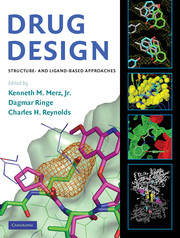Book contents
- Frontmatter
- Contents
- Contributors
- Preface
- DRUG DESIGN
- 1 Progress and issues for computationally guided lead discovery and optimization
- PART I STRUCTURAL BIOLOGY
- 2 X-ray crystallography in the service of structure-based drug design
- 3 Fragment-based structure-guided drug discovery: strategy, process, and lessons from human protein kinases
- 4 NMR in fragment-based drug discovery
- PART II COMPUTATIONAL CHEMISTRY METHODOLOGY
- PART III APPLICATIONS TO DRUG DISCOVERY
- Index
- References
2 - X-ray crystallography in the service of structure-based drug design
from PART I - STRUCTURAL BIOLOGY
Published online by Cambridge University Press: 06 July 2010
- Frontmatter
- Contents
- Contributors
- Preface
- DRUG DESIGN
- 1 Progress and issues for computationally guided lead discovery and optimization
- PART I STRUCTURAL BIOLOGY
- 2 X-ray crystallography in the service of structure-based drug design
- 3 Fragment-based structure-guided drug discovery: strategy, process, and lessons from human protein kinases
- 4 NMR in fragment-based drug discovery
- PART II COMPUTATIONAL CHEMISTRY METHODOLOGY
- PART III APPLICATIONS TO DRUG DISCOVERY
- Index
- References
Summary
Protein crystallography traditionally has been at the base of structure-based drug discovery (SBDD) by providing the structures of protein/ligand complexes that are often the starting point for the design and improvement of specific ligands. Consequently, an awareness of the strengths and weaknesses of this method is important for the success of ligand design. For instance, questions are often raised about the validity of a particular protein structure and whether that structure is relevant to the biological activity of the protein or about the conformation of a bound ligand and whether it represents a productive form. Some of these questions can be answered or at least addressed, whereas others cannot. There is an attempt to address those that can be addressed and to make some suggestions about those that cannot. Therefore, this chapter will focus more on the criteria that can be used to assess the quality of a structure determined by x-ray crystallography and less on the detailed methods used to achieve it.
BASIC CONCEPTS: CRYSTALLIZATION
The basic requirement for a crystal structure is a crystal. Although crystallization of proteins is still more of an art than a science, methods for routine searches of crystallization conditions are indeed available. Historically, the crystallization of proteins was a normal procedure used when working with an enzyme. Because of the known salting out effects of ammonium sulfate, this salt was used to induce selective crystallization, thereby purifying the protein.
- Type
- Chapter
- Information
- Drug DesignStructure- and Ligand-Based Approaches, pp. 17 - 29Publisher: Cambridge University PressPrint publication year: 2010
References
- 2
- Cited by



